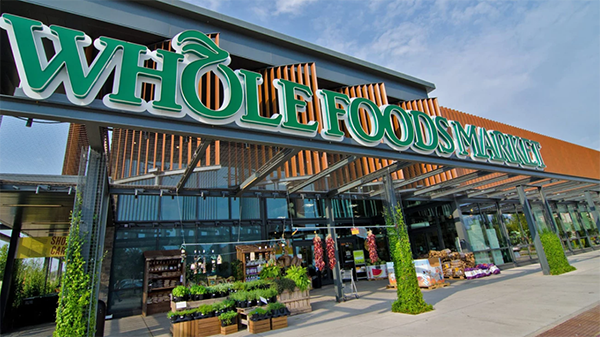Amazon’s BB #:283186 initial foray for its own branded grocery, Amazon Fresh, was an online-only venture.
“Amazon recognized that to grow it had to get into the food business, but it didn’t have the credibility,” says Bruce Peterson, CEO of Peterson Insights, Inc. in Bentonville, AR.
“Then it bought Whole Foods, which gave it instant cachet. It could leverage Whole Foods’ brick-and-mortar presence and give credibility to its own online presence.”
Whole Foods Market
Amazon’s ordering and delivery expertise, along with the forward distribution opportunities of Whole Foods’ locations, were perceived as advantages. But running a retail store is a far different business than ecommerce, which has been evident in quarterly results.
“Whole Foods has struggled,” says Ed McLaughlin, Robert G. Tobin professor of marketing emeritus at the Charles H. Dyson School of Applied Economics and Management at Cornell University in Ithaca, NY.
“Its market share fell during every quarter of the pandemic. Sales have declined since 2018, and same-store sales in April 2021 were the worst in store history.”
Foot traffic was also down, by 16.4 percent in May 2021 and 13.5 percent in June 2021, compared to the same months in 2019, according to location intelligence firm Placer.ai. But how much is attributable to Amazon’s ownership versus other factors is harder to define.
“Amazon wanted to make the retail prices in Whole Foods more competitive,” Peterson says. To do so, store labor was reduced to maintain margins.
“It’s hard to execute a complex merchandising scheme, and it’s even harder without enough labor—especially for fresh fruits and vegetables,” Peterson notes. “The store has been compromised, and Whole Foods is nowhere near the retailer it was before Amazon.”
Part of the restructuring was a new educational initiative called “Culture Champions,” designed to improve engagement and empower employees with a bottom-up culture rather than the usual top-down hierarchy. Whether this has an impact remains to be seen.
Despite any hurdles, however, diehard Whole Foods supporters still believe in the grocer, its brands, and mission and do not believe the chain has suffered unduly under its new corporate parent.
Rob Twyman, executive vice president of operations at Whole Foods, told Progressive Grocer in September 2021, “Amazon is still who they are, and we’re still who we are—and yet we’re learning from each other and growing,” he says. “With delivery, I think that’s a great example of where we’ve leveraged the two businesses together.”
Amazon Fresh
Aside from Whole Foods, Amazon is expanding its brick-and-mortar presence with its own brands. It launched a lower-priced Amazon Fresh store format during the pandemic, starting in southern California and the Chicagoland area, then moving to the East Coast, with an emphasis on online ordering with curbside pickup or delivery.
It reportedly has plans for more openings that would bring it close to 40 stores. Amazon Fresh locations range from 25,000 to 45,000 square feet and carry national, local, and regional brands, as well as private labels including Cursive, Aplenty, 365 by Whole Foods Market, and Amazon Fresh.
The stores include a staging area for order pickups and returns, with a selection of impulse convenience foods nearby. Amazon Fresh is not a head-on competitor for discounters or everyday low-price leaders like Walmart and Aldi, but hopes to attract shoppers from mid-range conventional grocers.
“Amazon has been slowly but steadily growing its brick-and-mortar store base in support of providing a full online grocery offering for local consumers across the country,” says Jon Hauptman, senior director of analytics at Inmar Intelligence in Winston-Salem, NC.
“While Amazon’s first attempt at local fulfillment was through existing Whole Foods stores, this approach was not the ideal solution,” he continues. “Whole Foods stores are not ubiquitously available across the country and don’t necessarily offer the assortment most of America is looking for.”
That being said, Amazon continues to operate more than 500 Whole Foods Market stores throughout the United States (with highest concentrations in California, Texas, Florida, Massachusetts, and Illinois) and has plans for several dozen more, with about a quarter of the new locations expected to be in California.
This is an excerpt from cover story of the November/December 2021 issue of Produce Blueprints Magazine. Click here to read the whole issue.



